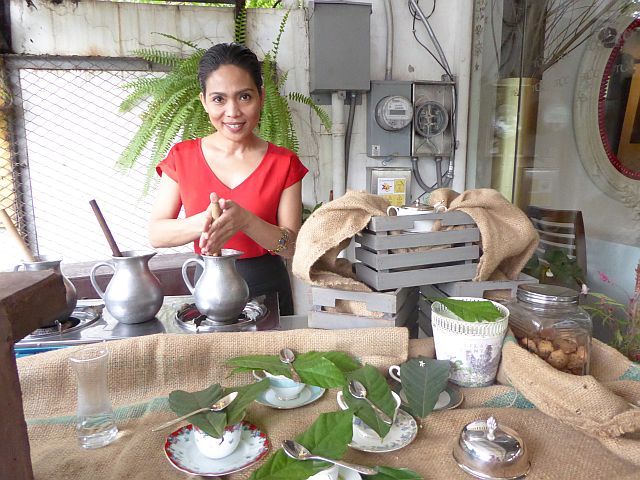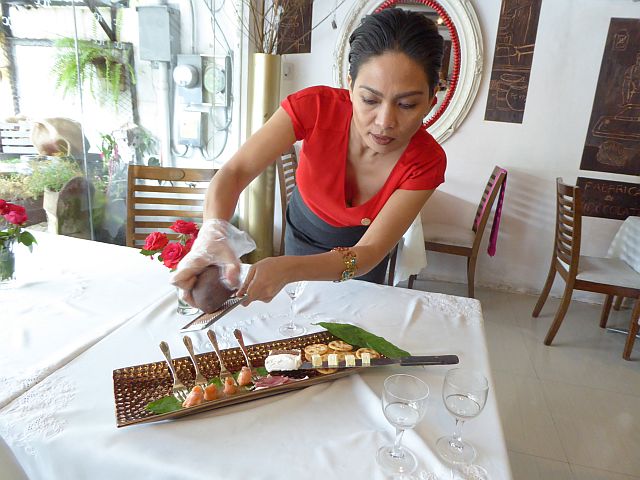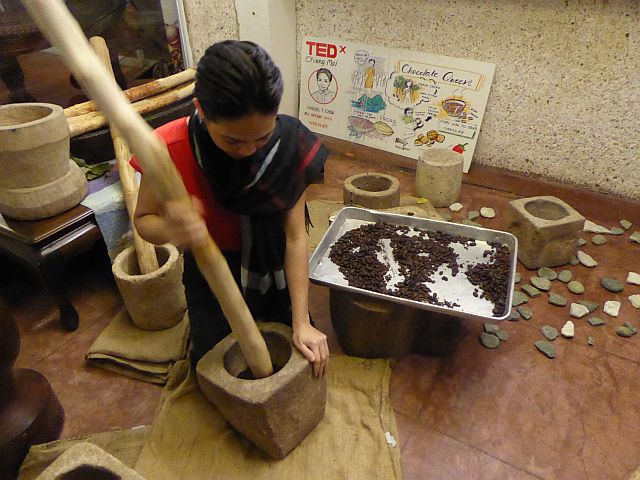
Preparing Sikwate using Chocolatera and Batidor. (JASON OLIVER DELA CRUZ)
THE GIRL who grew up in the secluded mountains of Balamban planting cacao trees and learning the art of making pure “tablea” under the watchful eyes of her grandmother Nanay Nila has rightfully earned her the title “Chocolate Queen.” She is creating a culture of excellence with her
cacao products of exceptional quality.
Inspired by the legend of “Maria Cacao,” her passion for cacao is elevating the Filipino chocolate to be at par with its world-class counterparts with her Ralfe Gourmet (RG) chocolate products. Her Chocolate Chamber Boutique retails and offers an interesting chocolate journey from the cacao plant, to the beans and learning the artisanal method of making the “tablea” or pure chocolate plumps and her signature Cacao de Bola.
The art of preparing the “Sikwate” or what I grew up with as “Chocolate E” using the chocoletera and batidor is truly amazing, with Raquel using her heightened senses to know the right consistency of the drink—rich, velvety and healthy!

Pouring smooth and silky Sikwate. (JASON OLIVER DELA CRUZ)
Before the Christmas season was over, we had the pleasure of experiencing a “Chocolatada” or a chocolate party that traces its origins in Peru. Hot Chocolate, after all, has become a tradition of Christmas also in the Philippines. This was Raquel’s first Chocolatada at her Casa de Cacao.
Upon arrival, Marketing Man Edu Pantino welcomed us as we were introduced to cacao trees planted in big pots. There was so much to learn about the cacao, from its leaves, tiny flowers to its fruit.

Raquel grating Cacao de Bola
on Salmon, ham and goat cheese. (JASON OLIVER DELA CRUZ)
A table was set up al fresco in the garden with a live cooking demo of preparing the different chocolate drinks using chocolatera and batirol. My granddaughter Sophie even tried using the batirol. Our hot choco degustation included Aztec or “bitter water” using 3 ½ pieces RG Tablea; Mayan or “bittersweet” with 3/12 pieces RG Tablea, 3 tbsp powdered milk, 2 tbsp sugar and 300 ml water; Mexican or “spiced” with the addition of cinnamon, vanilla and cayenne; Spanish or “milky and creamy” using RG Tablea, RG tsokolate Barby, condensed milk and 300 m water.
The Chocolatada started shortly after, which was held in the elegant Casa de Cacao with Spanish-inspired interiors. The chocolate paintings were very impressive, mural style and framed. An artfully arranged table set-up with chilled bottles of Prosecco, an array of appetizers like goat cheese, smoked salmon, prosciutto or parma ham, moist tablea cupcakes and her chocolate products. The star of the evening soiree was the Cacao de Bola.

Raquel pounding cocoa nibs using lusong and alho. (JASON OLIVER DELA CRUZ)
Using a hand grater, Raquel and her daughter Hannah grated the chocolate ball, sprinkling the finely shaved chocolate on top of the finger foods.
Later, Raquel obligingly demonstrated the Cacao de Bola artisanal method by pounding cacao nibs using the “aljo” or stone mortar and “lusong” or wooden pestle.
The cacao de Bola is strictly handmade, unlike the other chocolate products, which are produced with the help of machines. Her moves are so gracefully precise that it is such a joy to watch Raquel at work. With the right consistency after pounding, she forms a ball using her body energy to achieve the right shape. Voila! The versatile Cacao de Bola was adding flavor to all the hors d’oeuvres. And this ball of chocolate goodness is making the rounds—all over Metro Manila, in Guam, Malaysia, Indonesia, Colombia, and the latest in New York!

